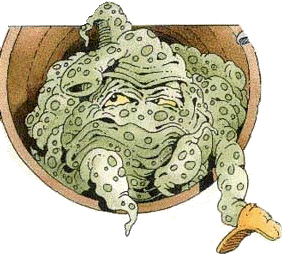
Answers
to the Most Frequently Asked Questions on Microbial Growth in Fuel
WHAT ARE MICRO-ORGANISMS OR BUGS?
The scientific names for the most common types of organisms that live
in petroleum products are Cladosporium resinae and Pseudomonas aeruginosa.
The organisms are either air or water borne and contaminate fuel systems
by entering through vents, standing water in sump bottoms, dissolved free
water or trash incurred during the transportation or delivery of the fuel.
WHAT DO THESE BUGS DO?
These slimy bugs live and multiply in the fuel/water interface. They
exist in the water and feed off the hydrocarbons in the fuel. They are
in the water and feed off the hydrocarbons in the fuel. They are referred
to as Hydrocarbon Utilizing Micro-organisms, commonly known as H.U.M. Bugs.
As they grow, they form mats that are dark in color and appear gel-like.
Their waste produces water, sludge, acids and other harmful by-products.
Micro-organisms will consume rubber gaskets, O-rings, hoses, tank linings
and coatings in an effort to obtain their mineral content.
DO THEY POSE A THREAT TO MY EQUIPMENT?
YES!! A major threat! Once they become established in fuel, they will
double in population every 20 minutes. Eventually they form a mat of black,
brown or green slime. This slime poses a serious hazard to both equipment
and storage facilities.
For example, its destructive forces will ...
... Clog fuel filters, fuel lines and gauges.
... Corrode pumps and injectors.
... Cause washers, hoses and connectors to swell and blister.
... Degrade fuel and cause poor fuel economy.
This contamination can also prevent water and particulate from settling
out of the fuel. Also, in plugging of filters and fuel and product lines,
contamination can cause unexpected and excessive down time, equipment failure
and/or unpreparedness in cases of emergencies or power outages for back-up
equipment.
CAN CONTAMINATED FUEL BE TREATED?
YES, but the fuel must be filtered
and the storage tank must also be cleaned. The CLEAN FUELS technology can
filter the fuel and clean the tank with its all-in-one process then add
an algaecide that can retard the growth of any remaining algae and then
kill these bugs.
WHAT CAUSES
MICROBIAL CONTAMINATION IN FUELS?
It is caused by living microscopic
cells. They can be either bacteria or fungus, such as mold. The same thing
happens to a loaf of bread or a piece of cheese. Even if kept refrigerated,
it can be contaminated with mold. The same thing occurs when fuel becomes
colonized by HYDROCARBON UTILIZING MICRO-ORGANISMS.
Microbes can enter the tank through
the vents, fill tubes or be sucked in by the breathing action of the fuel
tank during the fluctuation in temperature and tank volume. Also, fuel
that sits in a tank is more susceptible to contamination than fuel that
is rapidly consumed, such as fuel that is used for a back up generation
system compared to a high volume service station where the fuel is used
and replaced frequently.
WHERE DOES
THIS CONTAMINATION ORIGINATE?
Anywhere and everywhere! These
micro-organisms exist in air, water and soil. Every time fuel is handled,
the chance of contamination increases. What’s more, it occurs in virtually
any environment from the tropics to the high arctic.
CAN THE PRESENCE
OF THESE ORGANISMS BE DETECTED?
YES, there are two (2) ways.
1. BY VISUAL OBSERVATION, build
up of foul smelling (black, brown green or reddish) substances will be
found on fuel filters. Or CLEAN FUELS take a bottom sample directly from
the tank for you and put it in a transparent container so you can see it
yourself!
2. BY ANALYTICAL LABORATORY TESTING.
($200 to $700)
WHERE IS THE
BEST PLACE TO TAKE A FUEL SAMPLE?
The most accurate reading will
be from a tank bottom sample. This is the method used by CLEAN FUELS and
also this procedure is the standard measurement for the Environmental Protection
Agency (E.P.A.), American Society for Testing and Materials (A.S.T.M.)
and other state and local agencies as well as many air pollution control
districts.
HOW OFTEN
SHOULD FUEL BE SAMPLED?
Sampling at least once every quarter
is adequate. On average, every six month is acceptable and recommended.
Since microbe can double their population approximately every twenty (20)
minutes, the quality of the fuel will change rapidly.
SHOULD NEW
FUELS BE SAMPLED?
YES, even though fuel is sterilized
by the refining processed, there is no way of knowing how long this fuel
has been stored or the condition of the storage or transport vessel.
WHAT PRODUCTS
ARE SUSCEPTIBLE TO CONTAMINATION?
Diesel fuel is the most susceptible,
but definitely not the only product the can be affected. The following
is a list of the products that can be affected by H.U.M.:
JET FUEL DIESEL FUEL
AVGAS INSULATING FUEL
JP4 HYDRAULIC OIL
GASOLINE SELECTED SOLVENTS
CUTTING OILS SYNTHETIC OIL
The solution is simply a program of
sampling and purification by filtration. CLEAN FUELS can help your company
with these and other products to keep your fuels and tanks free from destructive
HYDROCARBON UTILIZING MICRO-ORGANISMS. |



